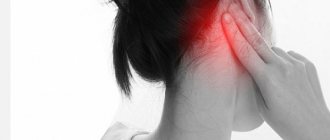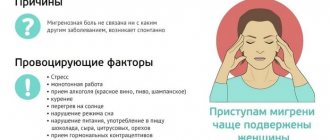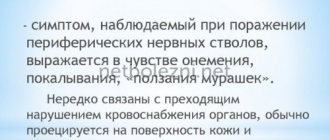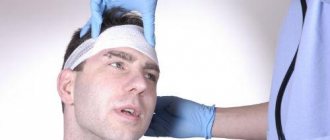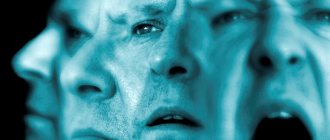Publication date: March 18, 2020
Such a symptom as parietal headache is familiar to many. Its appearance may be due to various reasons. The described problem can occur at any age – even in children. But most often it affects women aged 30-40 years in the premenstrual and menopausal periods, as well as in the third trimester of pregnancy.
Causes of shooting pain in the head
Migraine
This pathology is accompanied by unilateral pain of a pulsating nature (on the left or right), which is combined with lumbago in the head, neck and upper back. Before the onset of a migraine, a person may experience warning signs in the form of an aura. The clinical picture becomes intense under the influence of bright lighting, odors and loud sounds.
Cluster headache
With this pathology, attacks occur in series 2-10 times a day, lasting from 15 minutes to 1 hour. This phenomenon lasts for 2-3 weeks, and then gives way to a protracted period of remission.
Cluster headaches occur suddenly and are accompanied by lumbago in the back of the head, radiating to the eyeball. This symptomatology is very painful, as a result of which the person is unable to fully engage in normal activities. Before a cluster headache occurs, a person sometimes experiences blockage in one ear.
Concussion
Shooting in the head often occurs in a person who has previously suffered an injury such as a concussion. Pain syndrome is accompanied by the following symptoms:
- nausea;
- vomiting;
- dizziness;
- momentary fainting.
As soon as the functions of the organ are restored, the unpleasant symptoms will go away on their own without treatment.
Intracranial pressure
Shooting sensations in the temples are possible with increased intracranial pressure. The nature and type of symptoms depend on the degree of influence of the cerebrospinal fluid on brain tissue. In severe cases of pathology, the following signs are possible:
- convulsions;
- dizziness;
- vomit;
- nausea.
Ear infection
The inflammatory process occurring in the hearing organs leads to lumbago in the head and damage to the temporal bone. The culprit of the pain is purulent otitis media.
Trigeminal neuralgia
With this disease, lumbago is observed mainly in one half of the skull. The duration of the attack ranges from 10 seconds to 2 minutes. Symmetrical development of the symptom is extremely rare.
Spinal disorders
The pain syndrome is formed against the background of compression of the spinal nerves. The pain is one-sided and shooting, radiating to the back of the head, temporal parts and frontal lobes. The main reasons for its development are the following diseases:
- osteochondrosis;
- intervertebral hernia;
- disc protrusion;
- cervical spondylosis.
Cervical osteochondrosis
This disease is characterized by shooting headaches in the crown and back of the head. Patients complain of a crunching sound that occurs when turning their head, and numbness in their fingers. The intensity of the clinical picture increases at the end of the day or after prolonged exposure to an uncomfortable position.
Arthrosis
With this disease, the cartilage in the area of the intermaxillary joint becomes thinner, which can lead to a decrease in the functionality of the formation. Arthrosis at the initial stage of development leads to the development of symptoms such as clicking and rusting when moving the lower jaw. As soon as the pathological process has moved to a new level, the patient experiences more serious symptoms:
- when eating or talking, pain radiates to the head;
- hearing decreases;
- the jaw apparatus becomes numb;
- the face becomes asymmetrical.
Arthritis
This disease is characterized by dysfunction of the temporomandibular joint. In this case, the patient experiences pain similar to a migraine. Elderly people may suffer from temporal arthritis, which is characterized by inflammation of blood vessels, aneurysm of the carotid artery, causing lumbago in the temples and back of the head.
Tumor
When a tumor forms and grows, shooting pain in the head occurs intermittently or becomes permanent. It worries a person due to compression of tissues by the tumor. If the neoplasm is cancerous, then the toxins released by the conglomerate have a negative effect.
Calcium salt metabolism disorder
Failure in metabolic processes affects the formation of salt deposits in the joints and parts of the spine. This reduces the performance of systems and provokes the development of inflammatory processes. The patient complains of lumbago in the affected areas and head.
Symptoms of a nervous tic
Involuntary movements can affect only one muscle group - such tics are called local
.
There are also simple and complex tics. A simple tic is a complex of the simplest movements of the same type. With a complex tic, involuntary movements affect several muscle groups. A severe type of the disease is a generalized tic
, affecting almost the entire body. With this type of tic, involuntary movements usually begin in the face, then involve the muscles of the neck, shoulders, arms, chest, abdomen and back, and even legs.
Most often, tics affect the facial muscles. In this case, such movements as blinking, moving the lips, opening the mouth, moving the eyebrows, and twitching the nose are characteristic. When a tic spreads to the neck and shoulders, nodding and shaking of the head are typical. Tic spreading to the limbs is expressed in the form of flapping of arms, clapping of palms, stamping and jumping.
A group of vocal manifestations is also distinguished. In this case, screams, coughing, howling, uttering curses, and incoherent speech may be observed.
Diagnosis of cranialgia
To eliminate a shooting headache, it is necessary to determine what led to its development. First, you need to visit a therapist, who, after examination and tests, will refer you for a consultation to specialists of a narrow profile:
- ENT doctor. He will assess the condition of the hearing organs and examine the nasal cavity to exclude infectious diseases.
- Vertebrologist. He checks the condition of the spine to exclude cervical osteochondrosis.
- Neurologist. The doctor performs a brain examination to rule out dangerous diseases and inflammations.
If one of the above pathological processes was detected, the patient will need to undergo head and cervical diagnostics:
- MRI;
- X-ray;
- Ultrasound.
Diagnostics
The cause of the symptom is determined by a neurologist. If ear, nose, or paranasal sinus diseases are suspected, the patient is referred to an otolaryngologist. According to indications, consultations with an infectious disease specialist, traumatologist, psychotherapist, and other specialists are prescribed. The doctor collects an anamnesis of life and illness, conducts an external examination to identify possible changes (for example, wounds, hematomas). To clarify the diagnosis, the following are prescribed:
- Otorhinolaryngological examination
. Involves examination of available ENT organs, supplemented by the use of special devices to improve visualization. The most common techniques are otoscopy and rhinoscopy. Sinusoscopy is rarely performed during diagnostics due to its high invasiveness. - Neurological examination
. The specialist evaluates the symmetry of the face, pupils, and palpebral fissures. Examines muscle strength, range of motion, physiological reflexes, various types of sensitivity. Determines pathological reflexes, meningeal symptoms. Performs clinical topical diagnostics taking into account detected neurological disorders. - Radiography
. It is a mandatory diagnostic technique for injuries. Fractures of the parietal bone can be seen on photographs of the skull; fractures, dislocations, subluxations, and fracture-dislocations of the cervical vertebrae can be seen on radiographs of the spine. X-ray of the paranasal sinuses is widely used for sinusitis and mastoiditis, confirming the presence of dense masses in the sinus cavity, inflammatory changes in the mastoid process. - Other neuroimaging methods
. In the diagnostic process, MRI, Dopplerography, and duplex scanning are used. According to research, injuries, hydrocephalus, hemorrhages or areas of ischemia, displacement of the midline structures of the brain, sinusitis, and mastoiditis are confirmed. - Lumbar puncture.
Produced for intracranial hypertension, neuroinfections, and traumatic brain injuries. Helps confirm increased intracranial pressure, signs of inflammation or blood in the cerebrospinal fluid. - Lab tests
. A sample of cerebrospinal fluid obtained during a lumbar puncture can be examined by inoculation on nutrient media, microscopy, PCR, and ELISA. According to indications, general blood tests are performed to confirm inflammation, microbiological examination of discharge from the nose and ear.
Treatment of head injury
Methods for treating lumbago in the head
Pills
Acute diseases accompanied by severe pain must be treated in a hospital. If the cause of cranialgia is a bacterial infection, then the following drugs are effective:
- Antibiotics: Ampiox, Ceftriaxone, Zitrox. They can be prescribed in the form of tablets or injections.
- Anti-inflammatory medications: Indomethacin, Ibuprofen, Diclofenac.
- Combined medicines with analgesic effects: Spasgo, Spasmalgon.
- Vitamin B complex in the form of injections.
If lumbago in the head is caused by neuritis and muscle tension, then the following remedies are effective:
- Nootropic and neuroprotective medications in the form of injections and tablets: Actovegin, Thiocetam, Cortexin, Piracetam.
- Tranquilizers: Tozepam, Phenazepam.
To treat osteochondrosis, ointments containing non-steroidal components are included in the therapy:
- Fastum Gel;
- Diklak;
- Finalgon.
Exercise therapy
Simple physical exercises for the spine are indicated for eliminating the causes of the development of lumbago in the head and their prevention. All procedures are aimed at strengthening the muscle corset, improving posture, and normalizing blood flow in the cervical spine. A set of exercises is prescribed by a doctor, but in practice the following are most often used:
- Take a horizontal position, legs straight, arms along the body. Raise your head and remain in this position for 3-7 seconds. Repeat exercises 1-3 times.
- Place your hands on your shoulders and perform circular movements in one direction and then in the other direction 4 times. Repeat the exercises 2-3 times.
- Place your arms along your body, clasp your legs at the knees, and begin walking in a lying position. Perform for 30 seconds, do 2-4 repetitions.
- Place your arms along your body, then inhale and move them upward through your sides, while exhaling, pull your knees to your chest without lifting your head. Repeat exercises 4-6 times.
Massage
With the help of massage, you can work on soft tissues in superficial pathological processes. Thanks to the targeted effect on biologically active areas, it is possible to quickly relieve pain. To get maximum results, you need to use your fingertips to massage the brow ridges, the line between the eyebrows from the bridge of the nose to the place of hair growth, as well as the temples. Stroking the top of the head will help to consolidate the massage if you move towards the neck. Essential oils will help enhance the effect of the procedure:
- sandalwood;
- lavender;
- rosewood.
Physiotherapy
Physiotherapy is effective for shooting pain in the head. In inpatient settings, the following procedures are prescribed:
- electrophoresis;
- UHF;
- galvanic current;
- magnetotherapy.
At home, with the permission of a doctor, warm compresses and warm baths are allowed. According to indications, the doctor may prescribe acupuncture.
Prevention
To prevent lumbago in the head, you must follow simple rules that will not allow pain to develop:
- Head massage or exercise.
- Ventilate the room more often to prevent problems with blood vessels.
- Strong odors that lead to lumbago for no reason are undesirable.
- Review your diet, add fresh fruits and vegetables.
Cranialgia is a dangerous symptom that can signal a serious pathology. Only modern diagnostics and treatment will prevent the occurrence of severe complications, and adherence to prevention is an excellent guarantee of the development of unpleasant symptoms.
We recommend reading:
